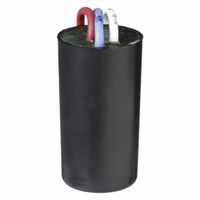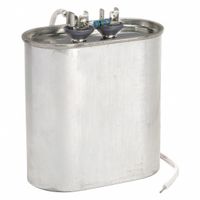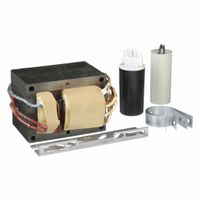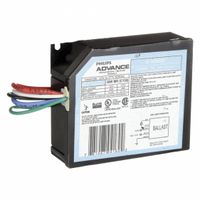Call +(254) 703 030 000 / 751 483 999 / 721 704 777
- Home
- Lighting
- Ballasts Drivers
- Hid Ballasts
HID Ballasts
HID (High-Intensity Discharge) ballasts pair with lighting fixtures that use metal-halide or high pressure sodium HID lamps. They protect from damaging power fluctuations that can reduce the lamps' light output quality. They provide an initial high voltage spike to turn on lamps and then regulate th .....Read More
Frequently Asked Questions
What is the difference between magnetic and electronic HID ballasts?
Magnetic and electronic HID (High-Intensity Discharge) ballasts are devices used to regulate the current and voltage supplied to HID lamps, but they differ in several key aspects:
1. **Technology**:
- **Magnetic Ballasts**: Utilize electromagnetic induction through coils and a core to regulate the current. They are relatively simple in design and have been used for many years.
- **Electronic Ballasts**: Use electronic components to control the current and voltage. They are more complex and incorporate microprocessors for precise control.
2. **Efficiency**:
- **Magnetic Ballasts**: Generally less efficient, as they consume more power and generate more heat. This can lead to energy losses.
- **Electronic Ballasts**: More energy-efficient, reducing power consumption and heat generation, which can lead to cost savings over time.
3. **Performance**:
- **Magnetic Ballasts**: Can cause flickering and produce a humming noise. They are also slower to start, taking longer to reach full brightness.
- **Electronic Ballasts**: Provide instant start and consistent light output without flickering. They operate silently and can improve lamp life by providing stable power.
4. **Size and Weight**:
- **Magnetic Ballasts**: Larger and heavier due to the use of coils and metal components.
- **Electronic Ballasts**: Smaller and lighter, making them easier to install and handle.
5. **Cost**:
- **Magnetic Ballasts**: Typically cheaper upfront but may incur higher operational costs due to inefficiency.
- **Electronic Ballasts**: Higher initial cost but can offer savings in energy and maintenance over time.
6. **Compatibility**:
- **Magnetic Ballasts**: Compatible with older lamp technologies.
- **Electronic Ballasts**: Often designed to work with newer lamp technologies and can offer more flexibility in lamp compatibility.
Overall, electronic ballasts are generally preferred for their efficiency, performance, and long-term cost benefits, despite a higher initial investment.
How do I know if my HID ballast is bad?
To determine if your HID ballast is bad, look for the following signs:
1. **Flickering Lights**: If your HID lights flicker or intermittently turn on and off, it could indicate a failing ballast.
2. **Dimming Lights**: A noticeable reduction in brightness can suggest that the ballast is not providing sufficient power to the bulb.
3. **No Light**: If the HID bulb does not light up at all, the ballast might be completely non-functional. Ensure the bulb itself is not burnt out before concluding the ballast is faulty.
4. **Buzzing or Humming Noise**: A loud or unusual noise coming from the ballast can be a sign of internal failure.
5. **Burnt Smell or Visible Damage**: A burnt smell or visible signs of damage, such as burn marks or melted components, indicate a bad ballast.
6. **Inconsistent Startup**: If the lights take longer than usual to start or require multiple attempts to turn on, the ballast may be failing.
7. **Error Codes**: Some vehicles with advanced diagnostic systems may display error codes related to lighting issues, which can point to a ballast problem.
8. **Swapping Test**: Swap the suspected bad ballast with a known good one from another light. If the problem resolves, the original ballast is likely bad.
9. **Voltage Test**: Use a multimeter to check the voltage output of the ballast. If it does not match the specified output, the ballast may be faulty.
10. **Bulb Test**: Test the HID bulb in a different, working ballast to ensure the bulb is not the issue.
If you observe any of these symptoms, it is advisable to replace the ballast to restore proper HID light function.
Can I use a metal-halide ballast with a high-pressure sodium lamp?
No, you cannot use a metal-halide ballast with a high-pressure sodium (HPS) lamp. Metal-halide and HPS lamps have different electrical requirements and operating characteristics. Metal-halide ballasts are designed to provide the specific voltage and current needed for metal-halide lamps, which have different starting and operating conditions compared to HPS lamps.
HPS lamps require a higher starting voltage and have different electrical characteristics, such as arc voltage and current, compared to metal-halide lamps. Using a metal-halide ballast with an HPS lamp can result in improper lamp operation, reduced efficiency, shortened lamp life, or even damage to the lamp and ballast.
For safe and optimal performance, always use the correct ballast type that matches the specific requirements of the lamp. If you need to operate an HPS lamp, use a ballast specifically designed for HPS lamps. Similarly, use a metal-halide ballast for metal-halide lamps. This ensures that the lamp receives the appropriate electrical conditions for proper ignition, operation, and longevity.
How do I replace an HID ballast?
1. **Safety First**: Turn off the power to the fixture at the circuit breaker to ensure safety. Use a voltage tester to confirm that the power is off.
2. **Access the Fixture**: Remove the fixture cover or lens to access the ballast. This may require unscrewing or unclipping parts of the fixture.
3. **Identify the Ballast**: Locate the ballast inside the fixture. It is usually a rectangular or cylindrical component with wires connected to it.
4. **Disconnect the Wires**: Note the wiring configuration or take a picture for reference. Disconnect the wires from the old ballast. This typically involves unscrewing wire nuts or disconnecting quick-connects.
5. **Remove the Old Ballast**: Unscrew or unclip the old ballast from the fixture. Keep any screws or clips for use with the new ballast.
6. **Select the New Ballast**: Ensure the new ballast is compatible with your fixture and lamp type. Check the voltage, wattage, and type (e.g., metal halide, high-pressure sodium).
7. **Install the New Ballast**: Position the new ballast in the fixture and secure it using the screws or clips from the old ballast.
8. **Reconnect the Wires**: Connect the wires from the new ballast to the fixture, matching the configuration noted earlier. Use wire nuts or quick-connects to secure the connections.
9. **Test the Connections**: Ensure all connections are secure and there are no exposed wires.
10. **Reassemble the Fixture**: Replace the fixture cover or lens, ensuring it is securely fastened.
11. **Restore Power**: Turn the power back on at the circuit breaker and test the fixture to ensure it operates correctly.
12. **Dispose of the Old Ballast**: Properly dispose of the old ballast, especially if it contains PCBs, by following local regulations.
What are the signs of a failing HID capacitor?
Signs of a failing HID (High-Intensity Discharge) capacitor include:
1. **Flickering Lights**: Inconsistent light output or flickering can indicate capacitor issues, as it fails to regulate the electrical current properly.
2. **Delayed Start**: A noticeable delay in the lamp reaching full brightness or taking longer to start can be a sign of capacitor failure.
3. **Dimming**: Reduced light output or dimming over time suggests the capacitor is not maintaining the necessary voltage levels.
4. **Humming or Buzzing Noise**: Unusual noises from the fixture can indicate electrical issues, often linked to a failing capacitor.
5. **Bulb Failure**: Frequent bulb replacements or premature bulb failure can be a result of capacitor malfunction, as it affects the overall electrical circuit stability.
6. **Physical Damage**: Visible signs of damage, such as bulging, leaking, or burnt marks on the capacitor, indicate it is failing or has failed.
7. **Overheating**: Excessive heat generation from the fixture can be due to a failing capacitor, which may not be dissipating energy efficiently.
8. **Inconsistent Color**: Changes in the color temperature or inconsistent color output can be a result of improper voltage regulation by the capacitor.
9. **Circuit Breaker Tripping**: Frequent tripping of circuit breakers can occur if the capacitor is causing electrical surges or short circuits.
10. **Increased Energy Consumption**: A failing capacitor may lead to higher energy usage as it struggles to maintain efficient operation.
11. **Burnt Smell**: A noticeable burnt odor near the fixture can indicate overheating or electrical failure related to the capacitor.
12. **Failure to Start**: Complete failure of the lamp to start can occur if the capacitor is no longer functioning, disrupting the electrical circuit.
How do I choose the right HID ballast for my fixture?
To choose the right HID ballast for your fixture, consider the following factors:
1. **Lamp Type and Wattage**: Ensure the ballast matches the specific type (e.g., metal halide, high-pressure sodium) and wattage of your HID lamp. Mismatched wattage can lead to poor performance or damage.
2. **Ballast Type**: Decide between magnetic and electronic ballasts. Magnetic ballasts are more traditional and durable, while electronic ballasts are more energy-efficient and offer better control over the light output.
3. **Voltage Compatibility**: Check the input voltage of your fixture and ensure the ballast is compatible. Common voltages include 120V, 208V, 240V, and 277V.
4. **Starting Method**: Choose the appropriate starting method for your lamp type. Probe start is common for older metal halide lamps, while pulse start is more efficient and extends lamp life. High-pressure sodium lamps typically use a different starting method.
5. **Ballast Factor**: This indicates the percentage of the lamp's rated lumen output the ballast will produce. A ballast factor of 1.0 means full output, while lower factors reduce output and energy consumption.
6. **Operating Environment**: Consider the environment where the fixture will be used. For outdoor or industrial settings, ensure the ballast is rated for the appropriate temperature range and is weather-resistant.
7. **Regulations and Certifications**: Ensure the ballast complies with local regulations and has necessary certifications like UL or CE for safety and performance standards.
8. **Dimming Capabilities**: If dimming is required, ensure the ballast supports it and is compatible with your control system.
9. **Brand and Warranty**: Opt for reputable brands that offer a good warranty, ensuring reliability and support.
10. **Cost and Efficiency**: Balance initial cost with long-term energy savings and maintenance costs. Electronic ballasts, though more expensive upfront, often offer better efficiency and lower operating costs.
What maintenance is required for HID ballasts?
HID (High-Intensity Discharge) ballasts require regular maintenance to ensure optimal performance and longevity. Here are the key maintenance tasks:
1. **Visual Inspection**: Regularly inspect the ballast for any signs of physical damage, corrosion, or overheating. Check for discoloration or burn marks, which may indicate electrical issues.
2. **Cleaning**: Dust and debris can accumulate on the ballast, leading to overheating. Clean the ballast and surrounding area with a dry cloth or compressed air to prevent dust buildup.
3. **Check Connections**: Ensure all electrical connections are secure. Loose connections can cause flickering or failure to start. Tighten any loose screws or connectors.
4. **Monitor Performance**: Pay attention to any changes in lighting performance, such as flickering, dimming, or delayed start. These can be signs of ballast failure or degradation.
5. **Temperature Management**: Ensure the ballast is operating within its specified temperature range. Overheating can lead to premature failure. Ensure adequate ventilation and avoid placing the ballast near heat sources.
6. **Inspect Wiring**: Check for any frayed or damaged wires. Replace any damaged wiring to prevent electrical hazards.
7. **Replace Aging Components**: Over time, components within the ballast may degrade. Follow manufacturer recommendations for replacing capacitors or other components as needed.
8. **Test Functionality**: Periodically test the ballast to ensure it is functioning correctly. Use a multimeter to check voltage and current levels.
9. **Follow Manufacturer Guidelines**: Adhere to the maintenance schedule and guidelines provided by the ballast manufacturer for specific maintenance tasks and intervals.
10. **Professional Inspection**: Consider having a professional electrician inspect the ballast periodically, especially if any issues are detected.
Regular maintenance of HID ballasts can prevent failures, extend their lifespan, and ensure consistent lighting performance.



